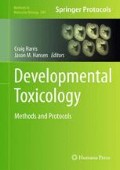Abstract
In vitro methods used to study the modes of action of developmental toxicants range in biological complexity from cell monocultures to the culture of intact viable conceptuses. Primitive methods were static in nature and generally failed to provide for the adequate transfer of oxygen and nutrients to the cells and tissues being cultured. Modern methods have improved on these deficits to allow growth of cells, tissues, and whole conceptuses at rates that mirror those seen in vivo. The experimental challenges encountered with in vitro studies are also not unlike those seen in vivo where scale, accessibility, and developmental timing continue to persist as significant challenges. In vitro models have advantages in the ability to control environmental conditions and the direct exposure to toxicants so that specific effects on cell growth, differentiation, and morphology can be assessed directly in cells that have retained a sufficient degree of pluripotency. In vitro methods range in biological complexity from primary and immortalized cell cultures, organ and tissue cultures, and whole embryo cultures using intact, viable conceptuses explanted from a variety of species. Different experimental approaches are used for the various stages of development and cover the spectrum from preimplantation, periimplantation, and on to postimplantation periods of development.
Access this chapter
Tax calculation will be finalised at checkout
Purchases are for personal use only
References
Harris C, Hansen JM (2006) In vitro methods for the study of mechanisms of developmental toxicology. In: Hood RD (ed) Developmental and reproductive toxicology – a practical approach, 2nd edn. Taylor and Francis, Boca Raton, pp 647–695
Trowell OA (1959) The culture of mature organs in a synthetic medium. Exp Cell Res 16:118
Neubert D, Barrach HJ (1977) Techniques applicable to study morphogenic differentiation of limb buds in organ culture. In: Neubert D, Merker HJ, Kwasigroch TE (eds) Methods in prenatal toxicology. George Thieme Publishers, Stuttgart, p 241
Loring J, Glimelius B, Erickson C, Weston JA (1981) Analysis of developmentally homogeneous neural crest cell populations in vitro. Dev Biol 82:86
Glimelius B, Weston JA (1981) Analysis of developmentally homogeneous neural crest cell populations in vitro, II. A tumor-promoter (TPA) delays differentiation and promotes cell proliferation. Dev Biol 82:95
Futaki S, Hayashi Y, Emoto T, Weber CN, Sekiguchi K (2004) Sox7 plays crucial roles in parietal endoderm differentiation in F9 embryonal carcinoma cells through regulating Gata-4 and Gata-6 expression. Mol Cell Biol 24: 10492–10503
Becker S, Casanova J, Grabel L (1992) Localization of endoderm-specific mRNAs in differentiating F9 embryoid bodies. Mech Dev 37:3–12
Pratt RM (1985) Receptor-dependent mechanisms of glucocorticoid and dioxin-induced cleft palate. Environ Health Perspect 61:35
Abbott BD, Buckalew AR (1992) Embryonic palatal responses to teratogens in serum-free organ culture. Teratology 45:369
Shiota K, Kosazuma T, Klug S, Neubert D (1990) Development of the fetal mouse palate in suspension organ culture. Acta Anat 137:59
Dunton A, Al-Alousi LA, Pratten MK, Beck F (1986) The giant yolk sac: a model for studying early placental transport. J Anat 145:189
Kollar EJ (1976) The use of organ cultures of embryonic tooth germs for teratological studies. In: Marois M (ed) Tests of teratogenicity in vitro. North Holland Publishers, Amsterdam, p 303
Lasnitzki I (1992) Organ culture. In: Freshney RI (ed) Animal cell culture: a practical approach. IRL, Oxford, p 213
Fisher KRS, Fedoroff S (1978) The development of chick spinal cord in tissue culture in Vitro. In Vitro 14:878
Author information
Authors and Affiliations
Corresponding author
Editor information
Editors and Affiliations
Rights and permissions
Copyright information
© 2012 Springer Science+Business Media, LLC
About this protocol
Cite this protocol
Harris, C. (2012). Overview of In Vitro Models in Developmental Toxicology. In: Harris, C., Hansen, J. (eds) Developmental Toxicology. Methods in Molecular Biology, vol 889. Humana Press, Totowa, NJ. https://doi.org/10.1007/978-1-61779-867-2_8
Download citation
DOI: https://doi.org/10.1007/978-1-61779-867-2_8
Published:
Publisher Name: Humana Press, Totowa, NJ
Print ISBN: 978-1-61779-866-5
Online ISBN: 978-1-61779-867-2
eBook Packages: Springer Protocols

